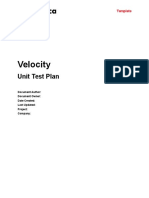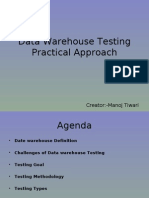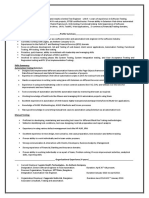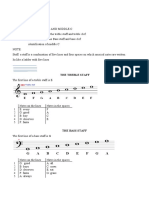Etl Testing
Etl Testing
Uploaded by
Katta SravanthiCopyright:
Available Formats
Etl Testing
Etl Testing
Uploaded by
Katta SravanthiCopyright
Available Formats
Share this document
Did you find this document useful?
Is this content inappropriate?
Copyright:
Available Formats
Etl Testing
Etl Testing
Uploaded by
Katta SravanthiCopyright:
Available Formats
ETL Testing: Testing is an important phase in the project lifecycle.
A structured well defined testing methodology involving comprehensive unit testing and system testing not only ensures smooth transition to the production environment but also a system without defects. The testing phase can be broadly classified into the following categories: * Integration Testing * System Testing * Regression Testing * Performance Testing * Operational Qualification Test Strategy: A test strategy is an outline that describes the test plan. It is created to inform the project team the objective, high level scope of the testin process. This includes the testing objective, methods of testing, resources, estimated timelines, environment etc. The test strategy is created based on high level design document.For each testing component test strategy needs to be created. based on this strategy testing process will be detailed out in the test plan. Test Planning: Test Planning is a key for successfully implementing the testing of a system. The deliverable is the actual Test Plan . A software project test plan is a document that describes the Purpose, System Overview, Approach to Testing, Test Planning, Defect Tracking, Test Environment, Test prerequisites and References. A key prerequisite for preparing a successful Test Plan is having approved (functional and non functional) requirements. Without the frozen requirements and specification the test plan will result in the lack of validation for the projects testing efforts. The process of preparing a test plan is a useful way to get to know how testing of a particular system can be carried out within the given time line provided the test plan should be thorough enough. The test plan outlines and defines the strategy and approach taken to perform end-to-end testing on a given project. The test plan describes the tasks, schedules, resources, and tools for integrating and testing the software application. It is intended for use by project personnel in understanding and carrying out prescribed test activities and in managing these activities through successful completion. The test plan objectives are as follows: * To define a testing approach, scope, out of scope and methodology that encompasses integration testing, system testing, performance testing and regression testing in one plan for the business and project team. * To verify the functional and non functional requirements are met. * To coordinate resources, environments into an integrated schedule. * To provide a plan that outlines the contents of detailed test cases scenarios for each of the four phases of testing.
* To determine a process for communicating issues resulting from the test phase. The contents of a typical test plan consist of the following: * An introduction that includes a purpose, Definition & Acronym, Assumptions & Dependencies, In scope, Out of scope, Roles& Responsibilities and contacts. This information is obtained from the requirements specification. * System Overview will explain about the background and the system description. * A test approach for all testing levels includes test Objectives for each level, Test responsibilities, Levels of testing, various testing, Test coverage, Testing tools, Test data and Test stop criteria. * Test planning specifies Test schedule, Documentation deliverables, Test communication and Critical and High risk functions. The test plan, thus, summarizes and consolidates information that is necessary for the efficient and effective conduct of testing. Design Specification, Requirement Document and Project plan supporting the finalization of testing are located in separate documents and are referenced in the test plan.
Test Estimation: Effective software project estimation is one of the most challenging and important activities in the testing activities. However, it is the most essential part of a proper project planning and control. Under-estimating a project leads to under-staffing it, running the risk of low quality deliverables and resulting in loss of credibility as deadlines are missed. So it is imperative to do a proper estimation during the planning stage. The basic steps in estimation include: * Estimating the size of the system to be tested. * Estimating the effort in person-hours (1 person hours number of working hour in a day i.e. 8 hours) After receiving the requirements the tester analyses the mappings that are created/modified and study about the changes made. Based on the impact analysis, the tester comes to know about how much time is needed for the whole testing process, which consists of mapping analysis, test case preparation, test execution, defect reporting, regression testing and final documentation. This calculated time is entered in the Estimation time sheet. Integration Testing: Integration testing is to verify the required functionality of a mapping (Single ETL / single session) in the environment specific to testing team (Test environment). This testing should ensure that correct numbers of rows (validated records) are transferred to the target from the source. Integration testing is also used to verify initialization and incremental mappings (sessions) functionality along with the pre-session and post-session scripts for dependencies and the usage/consumption of relative indicator files to control dependencies across multiple work streams (modules). During integration testing error-handling processes, proper functionality of mapping variables and the appropriate business requirements can be validated. Prerequisites: * Access to the required folders on the network.
* Implementation Checklist for move from development to test. * All unit testing completed and summarized. * Data available in the test environment. * Migration to the test environment from the development environment.
System Testing: This environment integrates the various components and runs as a single unit. This should include sequences of events that enable those different components to run as a single unit and validate the data flow. * Verify all the required functionality in the validation environment. * Run end-to-end system test. * Record initialization and incremental load statistics. * Perform and mitigate performance of the entire system. * Verify error-handling processes are working as designed. Prerequisites: * Finalized Implementation Checklist. * All integration testing complete. * Migration from the Test environment to the validation environment, as applicable. * Production configuration and data available. Regression Testing: Regression Testing is performed after the developer fixes a defect reported. This testing is to verify whether the identified defects are fixed and fixing of these defects does not introduce any other new defects in the system / application. This testing will also be performed when a Change Request is implemented on an existing production system. After the Change Request (CR) is approved, the testing team takes the impact analysis as input for designing the test cases for the CR. Prerequisites: * Finalized Implementation Checklist. * All integration testing complete. Performance Testing: To determine the system performance under a particular workload / Service Level Agreement (SLA).Ensures system meets the performance criteria and it can detect bottle neck. Types of Performance Testing are Load, Stress, Volume etc.
You might also like
- Anil Kumar - ETL Testing - 3.2 Yrs - ResumeDocument4 pagesAnil Kumar - ETL Testing - 3.2 Yrs - Resumeabreddy2003No ratings yet
- Intermittens 12 UnFaithopediaDocument64 pagesIntermittens 12 UnFaithopediaRozocran100% (1)
- Abhiram Kanumilli - Informatica DeveloperDocument7 pagesAbhiram Kanumilli - Informatica DeveloperBalu ReddyNo ratings yet
- Informatica Velocity Unit Test PlanDocument4 pagesInformatica Velocity Unit Test Plansrisrihk100% (1)
- ETL Testing Training Course ContentDocument7 pagesETL Testing Training Course ContentTekclassesNo ratings yet
- Teradata and ETL TestingDocument17 pagesTeradata and ETL TestingAnonymous xMYE0TiNBcNo ratings yet
- Calgary Cambridge GuideDocument4 pagesCalgary Cambridge GuideAnca TuchiacNo ratings yet
- Please Can Someone List What Are All The Testing Types Performed On ETL/DW Testing?Document3 pagesPlease Can Someone List What Are All The Testing Types Performed On ETL/DW Testing?Rajan SinghNo ratings yet
- Etl Tutorial PDFDocument2 pagesEtl Tutorial PDFSharonNo ratings yet
- Etl - Test - PlanDocument21 pagesEtl - Test - PlanSumit Shail100% (1)
- ETL Test CasesDocument14 pagesETL Test Casesnaveen.choragudi1122No ratings yet
- ETL Testing - Informatica With DWH Concepts: - Knowledge of Manual Testing - Knowledge of DBMS/SQL Is AdvantageousDocument2 pagesETL Testing - Informatica With DWH Concepts: - Knowledge of Manual Testing - Knowledge of DBMS/SQL Is AdvantageousSowbhagya VaderaNo ratings yet
- Certified ETL Testing ProfessionalDocument6 pagesCertified ETL Testing ProfessionalAnamika VermaNo ratings yet
- ETL Testing FundamentalsDocument5 pagesETL Testing FundamentalsPriya DharshiniNo ratings yet
- Mehjabeen ETL Testing ResumePDFDocument4 pagesMehjabeen ETL Testing ResumePDFMEHJABEEN SAYYEDNo ratings yet
- ETL Testing PDFDocument5 pagesETL Testing PDFpooh06100% (1)
- Basics of Database Testing Contains The FollowingDocument4 pagesBasics of Database Testing Contains The FollowingAnonymous xMYE0TiNBcNo ratings yet
- Etl TestingDocument25 pagesEtl TestingFI RO ZNo ratings yet
- ETL Test Plan Template Sample FileDocument5 pagesETL Test Plan Template Sample FileYogita SarangNo ratings yet
- Introduction To ETL and DataStageDocument48 pagesIntroduction To ETL and DataStageRavi MNo ratings yet
- DWH and Testing1Document11 pagesDWH and Testing1ramu546No ratings yet
- ETL Testing Training: Training Topics: Chapter 1: Data WarehousingDocument3 pagesETL Testing Training: Training Topics: Chapter 1: Data Warehousingnagushankar8840No ratings yet
- ETL Testing NotesDocument4 pagesETL Testing NotesThiru PasupuletiNo ratings yet
- Jasper Soft ETL.v4 enDocument5 pagesJasper Soft ETL.v4 enharoonobNo ratings yet
- Etl Testing Ebook PDFDocument2 pagesEtl Testing Ebook PDFMario0% (2)
- PraveenKumar 9884729497Document3 pagesPraveenKumar 9884729497Rajashekar ReddyNo ratings yet
- Etl Testing Guide - Types of Etl TestingDocument6 pagesEtl Testing Guide - Types of Etl TestingManohar ReddyNo ratings yet
- 78173829-4641-47df-8b8c-b1d48d367759.docxDocument4 pages78173829-4641-47df-8b8c-b1d48d367759.docxSarbashis PaulNo ratings yet
- ETL Process in Data Warehouse: Chirayu PoundarikDocument40 pagesETL Process in Data Warehouse: Chirayu PoundarikKarthik RaparthyNo ratings yet
- ETL Testing Resume 11Document4 pagesETL Testing Resume 11Pratik MuneNo ratings yet
- DW Basic + UnixDocument31 pagesDW Basic + UnixbabjeereddyNo ratings yet
- Business Intelligence (BI) Is A Technology-Driven Process For Analyzing Data and PresentingDocument26 pagesBusiness Intelligence (BI) Is A Technology-Driven Process For Analyzing Data and PresentingbabjeereddyNo ratings yet
- What Is ETLDocument47 pagesWhat Is ETLKoti BaswarajNo ratings yet
- QT ETL Testing Course ContentDocument12 pagesQT ETL Testing Course ContentHaribabu PalneediNo ratings yet
- Etl Testing New Faqs23Document3 pagesEtl Testing New Faqs23Jaya SankarNo ratings yet
- Project XplanationDocument4 pagesProject Xplanationvenkata ganga dhar gorrelaNo ratings yet
- ETL Testing  - Introduction - Tutorialspoint2Document3 pagesETL Testing  - Introduction - Tutorialspoint2jeffa123No ratings yet
- ETL Testing TechniquesDocument3 pagesETL Testing TechniquesgmkprasadNo ratings yet
- Etl Tool PDFDocument2 pagesEtl Tool PDFLatoyaNo ratings yet
- QS Tutorial - Writing SQL Queries Against Excel FilesDocument5 pagesQS Tutorial - Writing SQL Queries Against Excel FilesArturvillegasNo ratings yet
- Outline: ETL Extraction Transformation LoadingDocument38 pagesOutline: ETL Extraction Transformation Loadinghiprabu123No ratings yet
- Data Warehouse and Business Intelligence Testing: Challenges, Best Practices & The SolutionDocument15 pagesData Warehouse and Business Intelligence Testing: Challenges, Best Practices & The SolutionAnonymous S5fcPaNo ratings yet
- BI TestingDocument4 pagesBI Testingshanthi rajeshNo ratings yet
- Informatica: Business Information GroupDocument30 pagesInformatica: Business Information GroupVijayabharathi SingaramNo ratings yet
- FAQ Fo ETL TESTINGDocument9 pagesFAQ Fo ETL TESTINGmustaqNo ratings yet
- ETL TestingDocument5 pagesETL Testingpandian25100% (1)
- Anasuya VDocument3 pagesAnasuya VsudheersaidNo ratings yet
- ETL Testing GoalsDocument3 pagesETL Testing GoalssinhrajNo ratings yet
- What Are The Differences Between Connected and Unconnected Lookup?Document34 pagesWhat Are The Differences Between Connected and Unconnected Lookup?NivasChandraNo ratings yet
- ETL Testing Besant Technologies Course SyllabusDocument4 pagesETL Testing Besant Technologies Course SyllabusUday KiranNo ratings yet
- Performance Tuning in InformaticaDocument10 pagesPerformance Tuning in InformaticaDhananjay ReddyNo ratings yet
- Teradata Interview Questions and AnswersDocument21 pagesTeradata Interview Questions and AnswersSai VasuNo ratings yet
- TeradataDocument7 pagesTeradatakamalmse066072No ratings yet
- 03 - Quality Center Functionality and FeaturesDocument50 pages03 - Quality Center Functionality and Featuresakanksha0811No ratings yet
- ETL Informatica SDLCDocument2 pagesETL Informatica SDLCkamran100% (3)
- Accenture Interview Etl TestingDocument1 pageAccenture Interview Etl TestingparvezNo ratings yet
- ETL Testing ProcessDocument6 pagesETL Testing Processleogopal100% (2)
- 21 Etl Data Warehousing Project Life CycleDocument3 pages21 Etl Data Warehousing Project Life CycledvinuNo ratings yet
- Learn T-SQL Querying: A guide to developing efficient and elegant T-SQL codeFrom EverandLearn T-SQL Querying: A guide to developing efficient and elegant T-SQL codeNo ratings yet
- 138 - 1974 - Muslim LawDocument13 pages138 - 1974 - Muslim LawAditya MaheshwariNo ratings yet
- Ise Ii Conversation QuestionsDocument5 pagesIse Ii Conversation QuestionsHillary HernandezNo ratings yet
- 2standards Development in Facilities Management For WebDocument4 pages2standards Development in Facilities Management For WebzodhhashoNo ratings yet
- Comp1 Unit1 DiscussDocument4 pagesComp1 Unit1 DiscussP D SpencerNo ratings yet
- United States v. Lewis, A.F.C.C.A. (2014)Document13 pagesUnited States v. Lewis, A.F.C.C.A. (2014)Scribd Government DocsNo ratings yet
- CAE Reading and Use of English Practice Test 7 Printable - EngExam - InfoDocument2 pagesCAE Reading and Use of English Practice Test 7 Printable - EngExam - Infoanon92195No ratings yet
- C 469 PDFDocument5 pagesC 469 PDFTommy Cr100% (3)
- We Are Not Afraid To DieDocument4 pagesWe Are Not Afraid To DieRaju BhaiNo ratings yet
- Medical Emergencies Management GuidelinesDocument100 pagesMedical Emergencies Management GuidelinesMohamad khairil anwarNo ratings yet
- Sepsis Syndromes in Adults - Epidemiology, Definitions, Clinical Presentation, Diagnosis, and Prognosis - UpToDateDocument46 pagesSepsis Syndromes in Adults - Epidemiology, Definitions, Clinical Presentation, Diagnosis, and Prognosis - UpToDateparou haNo ratings yet
- Brand Valuation 1Document10 pagesBrand Valuation 1Amanda MeitaNo ratings yet
- Subtitles Never Give UpDocument63 pagesSubtitles Never Give Upyoanageorgieva007No ratings yet
- EDUC 55 Review Questions: 6. When Can A Teacher Be Granted An Indefinite Leave?Document21 pagesEDUC 55 Review Questions: 6. When Can A Teacher Be Granted An Indefinite Leave?China May SabanganNo ratings yet
- Desvenlafaxine Venlafaxine: StructureDocument6 pagesDesvenlafaxine Venlafaxine: StructureAndrew PanickerNo ratings yet
- Bscmathsv&ViDocument11 pagesBscmathsv&ViDhiraj RajputNo ratings yet
- Modul RadiusDocument57 pagesModul RadiusMuharom Mam'zelleNo ratings yet
- OPS - Crew Development Program Introduction, Revised Dec2010Document5 pagesOPS - Crew Development Program Introduction, Revised Dec2010tkdjohn1No ratings yet
- Pinheiro PrinciplesDocument113 pagesPinheiro PrinciplesErato Kozakou MarcoullisNo ratings yet
- FCFF and FCFE ApproachesDocument22 pagesFCFF and FCFE Approachesd ddNo ratings yet
- Veloso - v. - China - Airlines - Ltd.Document5 pagesVeloso - v. - China - Airlines - Ltd.ChristineNo ratings yet
- Grade 3 Note - Week 1Document3 pagesGrade 3 Note - Week 1OSUJI UgochukwuNo ratings yet
- QuestionDocument63 pagesQuestionEdwin JohnNo ratings yet
- Take-Home Test - ANSWERSDocument4 pagesTake-Home Test - ANSWERSSahibNo ratings yet
- Theories of Crime Causation (Explanations For The Causes of Crime)Document95 pagesTheories of Crime Causation (Explanations For The Causes of Crime)Borga DabaNo ratings yet
- AKI and Collapsing Glomerulopathy Associated With.10Document8 pagesAKI and Collapsing Glomerulopathy Associated With.10Arista RachmaNo ratings yet
- Project Report: "Study On Portfolio Management Services Strategies and Investors Awareness and Prefrence For It"Document49 pagesProject Report: "Study On Portfolio Management Services Strategies and Investors Awareness and Prefrence For It"Nitesh BaglaNo ratings yet
- People vs. Cheng - People vs. PajenadoDocument3 pagesPeople vs. Cheng - People vs. PajenadoAnne Laraga LuansingNo ratings yet
- Las:q2 Health Grade 8Document4 pagesLas:q2 Health Grade 8MARY CRIST HENONNo ratings yet

























































































